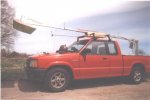WHY, WHY, WHY do we have to read about people being killed time after time in the gyro community in these unstable dangerous machines?
If these were high powered high performance cars sold as kits by some company with sloppy tie rods in the steering that could only be driven by highly trained highly skilled people and even then there was a steady stream of fatal accidents caused by sloppy steering, how many years could such a company stay in business?
What is wrong with the gyroplane community that seperates them from the rest of aviation that allows a few to keep defending something that can be cured by changing a design?
Or am I just making unfounded assumptions because I am biased?
What a dismal way for everyone here to start another day thinking about another family suffering the loss of a family member flying for fun.
Chuck E.
There's one answer that comes to my head everytime I read that question, Chuck: Education.
I don't think the average gyro pilot understands the physics behind what they're flying. There are a few of you who have a great understanding and are nice enough to enlighten the rest of us, but the message is not getting to the masses.
I'd like to think that none of you gyro pilots have a death wish. If someone were to actually be convinced their aircraft could kill them, I can't see them flying it. And by convinced, I mean getting past the ignorant "it won't happen to me" mentality that seems to plague any accident, gyro related or not.
Something else that sets gyro flying apart from other forms of transportation is a governing body that ensures the safety of pilots. The FAA and NTSB don't have gyro accidents as a top priority. As experimental aircraft, maybe that's a loophole that allows them to disregard normal investigation proticol and move on to something else. As someone else pointed out, there's no shortage in aerospace accidents to look into. This forum is probably the only place in the world you're going to find knowledgable people on the topic of PIO, PPO, HTL and gyro stability in general. And for every member you have here, you have dozens of others who simply may not know the potential risks of flying a HTL machine.
Gyros may also be regarded as the "cheap" alternative to flight. With that mentality, the aircraft is not given the respect it deserves. I mean, it's just a goftcart with
helicopter wings and a lawnmower engine, right? Unless they stumble across this website or a PRA chapter, they may never know the difference. And even within this community we can't all agree as to what is safe to fly and what isn't.
Scientific processes and experiments have to be completed and documented. That documentation has to be recognized as truth and someone with authority has to impliment these as laws. Without that, there is still a lining of myth and lore surrounding gyros. Without anyone telling RAF to do otherwise, they're able to market and bambazoole whomever they want. And what's worse, those salesmen may not even realize what they're doing and even if they have heard, they'd never believe it.
I don't know... it all seems simple to me. A bit of an outside prespective maybe. I don't fly, maybe that makes me unbiased. I live by numbers, calculations and physics. To me, I know a system that is not in equilibrium has to be moving. It's that simple. To others, the instance you mention moments, vectors and equilibrium, you might lose them completely.

